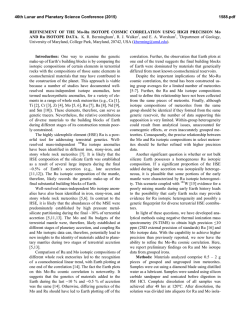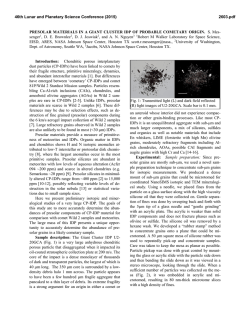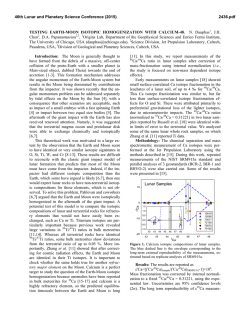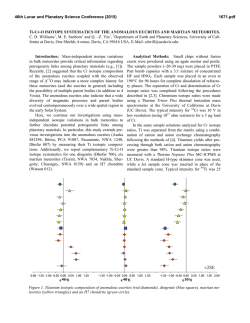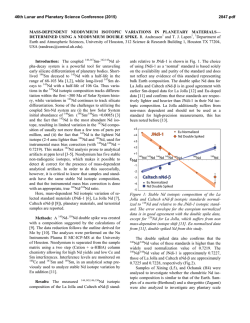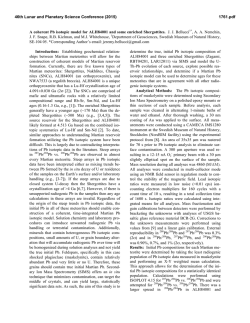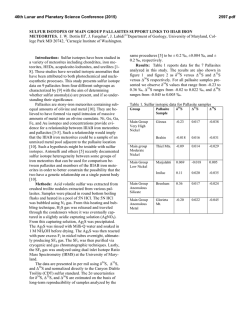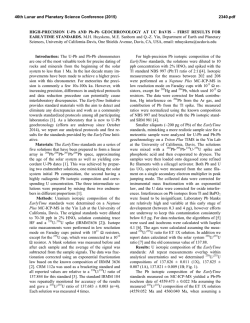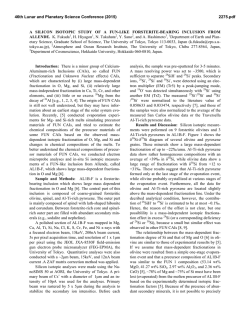
Molybdenum Isotope Evidence for Diverse Genetics Among IAB Iron
46th Lunar and Planetary Science Conference (2015) 2524.pdf MOLYBDENUM ISOTOPE EVIDENCE FOR DIVERSE GENETICS AMONG IAB IRON METEORITE COMPLEX SUBGROUPS. E.A. Worsham1 and R.J. Walker1, 1Dept. of Geology, University of Maryland, College Park, MD 20742 USA ([email protected]). Introduction: The IAB complex is a silicatebearing iron meteorite group consisting of a chemical main group (MG) and several subgroups (e.g., sLL, sHL) [1]. Based on trace element relationships, previous studies of the IAB complex concluded that relative and absolute trace element abundances of the IAB subgroups differ significantly from one another. This suggests that the subgroups cannot be related to one another by crystal-liquid fractionation, indicating that each group had a distinct initial chemical composition [1, 2]. Generally, iron meteorites from the same group are assumed to have originated on the same parent body (e.g., IVB). Trace elements show that this is not necessarily the case for the IAB complex. Proposed origins of the IAB complex include crystallization of a S-rich core in a partially differentiated body [3], crystal segregation in impact-generated melt pools in a chondritic body [1], and core formation in a partially differentiated body, followed by an impact(s) which disrupted the body and generated near-surface melt pools [46]. Any of these scenarios may have occurred on multiple parent bodies to generate the IAB complex. To better understand how the constituent IAB subgroups may be related, we have undertaken a study to examine the genetic relations of the IAB complex using Mo isotopic compositions of MG, sLL, sLM, sHL, and sHH irons. As most planetary bodies show distinct Mo isotopic compositions, due to nucleosynthetic heterogeneities, it is possible to reject genetic linkages among meteoritic material if isotopic differences can be resolved [7, 8]. When Mo isotopic compositions are applied as genetic fingerprints to individual subgroups within the IAB complex, the question of whether they originated on the same parent body, or if they formed via similar processes on distinct parent bodies, can be addressed. If it can be shown that the IAB complex represents multiple parent bodies, then it might ultimately be concluded that the processes that created the chemically and texturally similar subgroups were temporally and/or spatially widespread. Experimental Methods: The digestion and chromatography methods for Mo analyses were adapted from [8-10]. Some samples included in the MG and sLL means were processed and analyzed under different conditions than later samples, but have 95Mo/96Mo ratios that are in agreement with MG and sLL samples that were processed in the same way as irons from the other subgroups. For most samples, Mo was collected from the same irons used for W isotopic analysis [2]. Fig. 1. μ95Mo for IAB complex iron meteorites, with the IVB iron meteorite group for reference. The grey bar indicates the external reproducibility (2σ) of repeated analyses of a terrestrial standard. The dotted lines represent the external reproducibility of standards which were corrected without the line by line O correction, and incidentally, the external reproducibility of [8]. Excluding means, each data point represents one analysis, and uncertainties are the 2σ external reproducibility or the internal 2SE of the analysis, whichever is larger. The uncertainties reported for means are 2σ of the analyses. Molybdenum isotope compositions were determined using a Thermo-Fisher Triton Plus TIMS, operated in negative mode. All Mo isotopes were measured as MoO3-, which requires an O correction to account for interferences caused by 17O and 18O. To make this correction, MoO3- beams were collected concurrently with 18O/16O (measured as 100Mo18O16O2) using Faraday cup detectors that were tied to amplifiers equipped with a mixed array of 1011 and 1012 Ω resistors [11]. The 18O/16O ratios were used for an in situ O correction. This correction was applied to each collection cycle to account for changing 18O/16O during an analysis. For each cycle, data was collected for ~ 2 minutes to improve the statistics of the 18O/16O measurements, with a total of 150-250 cycles. The external reproducibility (2σ) of repeated analyses of terrestrial standards without the line by line O correction, using the O isotopic composition of [12], is ± 26 ppm for 95Mo. With the line by line O correction, the external reproducibility is ± 7.7 ppm for 95Mo. Some of the data included in 46th Lunar and Planetary Science Conference (2015) the MG, sLL, and Sombrerete means were obtained with and without the in situ O isotope measurements. The Mo isotopic compositions are reported in μ notation (parts in 1,000,000 deviation from terrestrial standards), which ranges in iron meteorites from 0 to ~ +100 μ95Mo [7, 8]. The data are normalized to 98 Mo/96Mo = 1.453171, as in [8]. Results: Most IAB complex iron meteorites reported here have Mo isotopic compositions that are within uncertainty of the terrestrial Mo isotopic composition (Fig. 1). μ95Mo obtained from three iron meteorites from the MG; three from sLL; a representative sample from sLM, sHL, and sHH; and Caddo County, a IAB iron meteorite that does not belong to any of the subgroups, are reported here (Fig. 1). The MG, sLL, and Persimmon Creek (sLM) samples have indistinguishable Mo isotopic compositions (μ95Mo= -0.04 ± 7.8, -9.3 ± 5.0, and -1.5 ± 7.7), in agreement with [8, 13]. Sombrerete (sHL) and ALHA80104 (sHH) are not within uncertainty of each other, terrestrial Mo, or the other IAB subgroups (μ95Mo= 105 ± 6.2 and 36 ± 7.7). Caddo County has a Mo isotopic composition that is within uncertainty of the sLL subgroup, but not the MG, sLM, or terrestrial Mo (μ95Mo= -20 ± 7.7). Discussion: The Mo isotope evidence is permissible of most IAB subgroups having their origin on the same parent body. However, Sombrerete and ALHA80104, having well resolved differences in μ95Mo, likely originated on different parent bodies from other subgroups. If these irons are representative of sHL and sHH, then neither of the two high-Au subgroups of the IAB complex are related to the IAB-MG. This conclusion is in agreement with that of [7], in which the authors reported that the Mo isotopic composition of Magnesia (sHL) does not overlap with that of Canyon Diablo (MG). Further, Sombrerete has a lower Δ17O than most IAB complex irons [1], and ALHA80104 has an older Hf-W metal segregation model age [2, oral presentation]. These additional lines of evidence also support the conclusion drawn from Mo isotopes that these samples are unrelated to the IAB-MG. Moreover, because nebular heterogeneity is the source of the Mo isotopic anomalies, these irons, which originated on separate parent bodies, likely originated in isotopically distinct nebular environments. Evidence from the Hf-W system suggests that Persimmon Creek, which has an indistinguishable μ95Mo from the MG, records a later metal segregation event than the MG [2, oral presentation]. This observation suggests that this sample, and the sLM subgroup, either formed on the same parent body as the MG at different times, or on distinct parent bodies in similar nebular environments. If Persimmon Creek formed on 2524.pdf the same parent body, it suggests that the IAB parent body had a protracted history, and it supports the idea that at least some of these subgroups formed via impact melting. The implication of the latter is that solar system objects formed at different times are, due to the nature of early solar system evolution, formed in different locations. To first order, objects closer to the proto-Sun have been suggested to have formed earlier, and vice versa. Therefore, the Mo isotopic homogeneity of the MG, sLL, and sLM subgroups, which formed at different times (and likely different locations), suggests some degree of nebular homogenization of Mo isotopic compositions. Caddo County is classified as an ungrouped member of the IAB complex. Wasson and Kallemeyn (2002) assigned it to the Udei Station grouplet, but because this grouplet only has 3 members, it was not considered a subgroup. Caddo County shows a narrowly resolved negative μ95Mo, which is the first example of a negative Mo isotopic deviation when the data are normalized to 98Mo/96Mo [8]. The Caddo County data of [8] are in agreement with those presented here, but were not sufficiently precise to resolve from terrestrial. The nucleosynthetic anomalies in Mo isotopic compositions of solar system materials are typically attributed to a deficit of Mo isotopes that are produced by sprocess nucleosynthesis of asymptotic giant branch stars. These data suggest that Caddo County may have sampled a previously ambiguous s-process excess. Therefore, Caddo County may not only be unrelated to the IAB-MG, but also unlike most other iron meteorites analyzed thus far for Mo isotopic anomalies. Additional data will be required to corroborate this finding. The IAB complex likely does not represent a single parent body. Therefore, chemical similarities within the complex suggest that the processes that created these meteorites were widespread in time and space. Acknowledgement: Samples for this study were generously provided by the Smithsonian Institution National Museum of Natural History. References: [1] Wasson, J.T., Kallemeyn, G.W. (2002) Geochim.Cosmochim. Acta, 66, 2445-2473. [2] Worsham, E.A. et al. (2014) LPSC XLV, #2395 [3] Kracher, A. (1985) J. Geophys. Res., 90, 2419-2426. [4] Benedix, G.K. et al. (2000) Meteorit. Planet. Sci., 35, 1127-1141. [5] Ruzicka, A., Hutson, M. (2010) Geochim. Cosmochim. Acta, 74, 394433. [6] Schulz, T. et al. (2012) Geochim. Cosmochim. Acta, 85, 200-212. [7] Dauphas, N. et al. (2002) Astrophys. J., 565, 640-644. [8] Burkhardt et al. (2011) Earth & Planet. Sci. Lett., 312, 390-400. [9] Pietruszka, A.J. et al. (2006) Chem. Geol., 225, 121-136. [10] Touboul, M., Walker, R.J. (2011) Int. J. Mass Spectrometry 309, 109-117. [11] Luguet, A., et al. (2008) Chem. Geol., 248, 342-362. [12] Nier, A.O. (1950) Phys. Rev., 77, 789-793. [13] Worsham, E.A. et al. (2013) LPSC XLIV, #2456
© Copyright 2025

